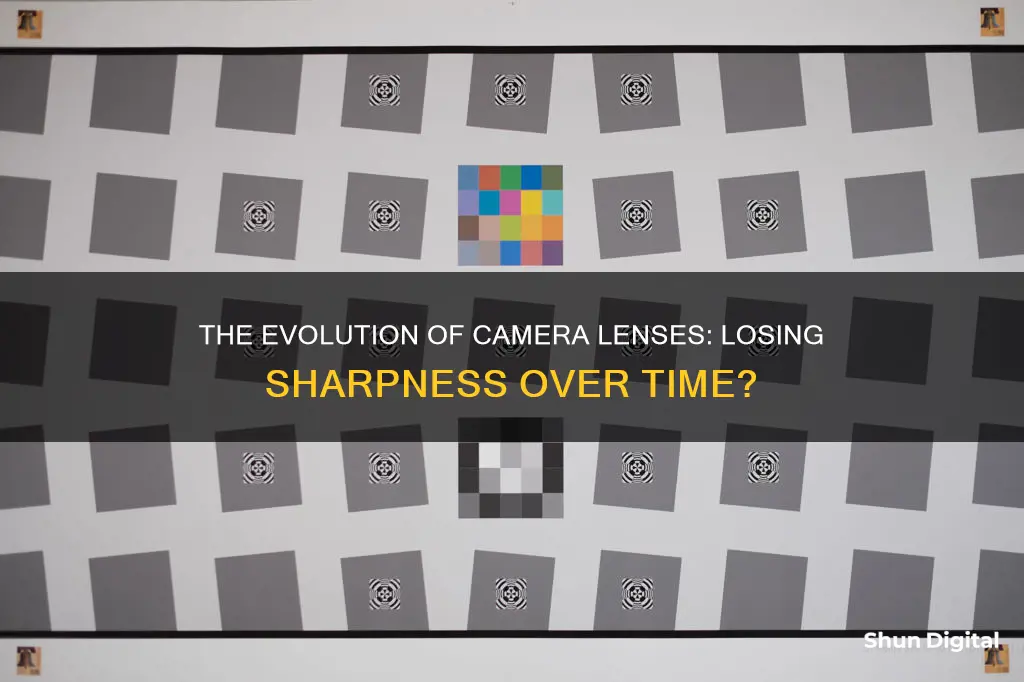
Camera lenses are made of glass, which is a fixed medium. Therefore, age alone will not cause a lens to lose sharpness. However, other factors can affect the sharpness of a lens over time, such as wear and tear, dust, fungus, and damage. For example, a lens can get dirty, scratched, or knocked, causing a decrease in sharpness. Additionally, the glue that holds lens elements together may deteriorate, leading to misalignment and reduced sharpness. Proper maintenance, storage, and care can help extend the sharpness of a lens.
| Characteristics | Values |
|---|---|
| Do camera lenses lose sharpness over time? | In general, lenses won't naturally lose sharpness over time. However, age will not prevent other issues from occurring. |
| Reasons for sharpness loss | Wear and tear, dust, fungus, scratches, misalignment, knocks, manufacturing problems, glue deterioration, coating deterioration, extreme temperatures and humidity. |
| Lens maintenance | Keep the lens stored in a cool, dry, clean environment, out of harm's way. |
| Checking sharpness | Shoot distant natural objects with fine details. |
| Improving camera quality | Use natural light, keep the camera steady, and frame shots carefully. |
What You'll Learn

Fungus and moisture
Camera lenses are susceptible to fungus growth, especially in humid environments. This can occur when dust containing fungus spores combines with moisture, which then finds its way into the interior elements of the lens. Lenses that are not weather-sealed are more prone to this issue. Fungus can cause permanent damage to the lens, resulting in fuzzy or hazy images. To prevent fungal growth, it is essential to store lenses in cool, dry places, away from direct sunlight, and to regularly check for any signs of fungus.
Fungus tends to thrive in dark and moist environments, so proper storage is crucial. If you plan to store lenses for an extended period, consider using a see-through or humidity-controlled cabinet with silica gel packets. Silica gel absorbs moisture, while the transparent container allows light to pass through, inhibiting fungus growth. It is also important to monitor the moisture and temperature levels in the storage environment.
To check for fungal growth, remove the lens from the camera and take off the front and rear lens caps. Examine both ends of the lens for any signs of fungus, such as web-like spots or patches. If you suspect the presence of fungus, it is recommended to consult a professional lens technician for evaluation and potential cleaning.
Fungus can significantly impact the performance and value of a lens. It can etch into coatings and elements, compromising sharpness and image quality. Even if the fungus does not immediately affect image quality, it is a living organism that can continue to grow and cause further damage over time. Therefore, addressing fungal growth promptly is essential for maintaining the condition and functionality of your camera lenses.
Olympus 4/3 Camera Lenses: Discontinuation and What's Next
You may want to see also

Coating and glue deterioration
While camera lenses do not lose sharpness with age, the seals, coatings, and glue that holds the lens together may deteriorate over time. The glue bonding lens elements can become opaque, and the lens may need to be un-glued, cleaned, and glued again. This is a risky operation, and opinions vary on whether it is worth it for inexpensive lenses.
The "glue" used to bond lens elements is usually a natural resin such as Canada Balsam, which must be carefully matched to the refractive index of the lens elements. Over time, the cement can absorb moisture, which can result in the lens becoming opaque. This deterioration is more likely to occur in high humidity and temperature environments.
In addition to glue deterioration, coatings on lenses can also be damaged. While minor defects are unlikely to significantly affect photos, excessive cleaning can damage a coating or scratch a lens.
Full-Frame Lenses: Sharper on Crop Sensor Cameras?
You may want to see also

Extreme temperature and humidity
Extreme temperatures and humidity can cause problems for camera lenses. The main issue is condensation, which can occur when a camera is moved between environments with very different temperatures. Condensation can cause mineral deposits on the lens, and can also trap dust and cause fungus to grow. To avoid condensation, it's best to put your camera in a sealed bag before moving it from a cold to warm environment.
Another issue is that extreme cold can cause batteries to deplete very quickly. It's recommended to carry spare batteries and keep them warm inside your clothing.
In addition, drastic changes in temperature and humidity can cause slight warping or deformation of lens elements, affecting their optical performance.
Cameras and Lenses: Capturing the 3D World
You may want to see also

Physical damage
More significantly, a hard knock or drop can cause the internal precision elements of the lens to shift and become misaligned, leading to softness in images, especially when using a wide aperture such as f/1.4. This type of physical damage can be challenging and costly to repair and may require the expertise of a specialist.
It is worth noting that age alone will not cause a lens to lose sharpness. Glass is a fixed medium, and assuming the lens is well-maintained and free from issues like dust, fungus, or physical damage, it should retain its sharpness over time. However, physical damage can occur as a result of ageing, such as the deterioration of seals, coatings, and glue, which may impact sharpness.
Interchangeable Lens Cameras: Are They Worth the Hype?
You may want to see also

Dust and particles
Dust can enter the lens during the focusing procedure and through the gap between the lens and the camera body when swapping lenses. It is advisable to minimise dust exposure by storing your camera in a clean, dry place, such as a camera bag, and to use lens caps and hoods for protection.
If dust is causing issues, it is important to clean the lens carefully. Compressed air blowers, soft brushes, lens cleaning solutions, and microfiber cloths are recommended tools for this delicate process. It is best to have a professional technician perform the cleaning unless you are confident in your abilities and have the necessary tools.
While dust inside a lens can impact image quality, it is important to note that the amount of dust required to cause noticeable effects is typically significant, and minor dust accumulation will likely have a negligible impact.
Universal Camera Lenses: A Myth or Reality?
You may want to see also
Frequently asked questions
Camera lenses generally do not lose sharpness over time if they are well-maintained and free from dust, fungus, or damage. However, age can cause the glue that holds lens elements together to deteriorate, leading to misalignment and reduced sharpness.
Factors that can contribute to a loss in sharpness include wear and tear, dust or fungus on the lens surfaces, extreme temperatures or humidity, and physical impacts that cause misalignment of lens elements.
To check the sharpness of your lens, find a distant natural object with fine details, such as trees or mountains, and shoot from an elevated position when the weather is clear. Ensure your focus is accurate, as even slight errors can cause blurriness.







